アインシュタインは何した人?功績や人物像を簡単に解説します
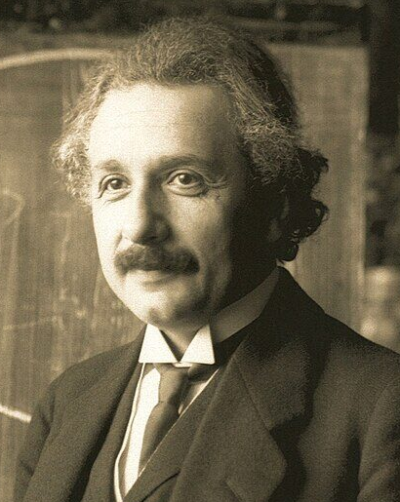
“What Did Einstein Do? Exploring His Achievements and Persona”
イントロダクション
20世紀を代表する物理学者といえば、誰もが真っ先に思い浮かべるのがアルベルト・アインシュタインでしょう。
彼の名前は、物理学の歴史において燦然と輝く存在です。
1905年、アインシュタインは「奇跡の年」と呼ばれる年に4本の論文を発表し、その中でも特に有名なのが特殊相対性理論です。
この理論は、エネルギーと質量の関係を示す有名な方程式E=mc²を含んでおり、物理学の根本的な概念を一変させました。
アインシュタインの理論は、当時の科学界に激震を与えただけでなく、現代の技術にも多大な影響を及ぼしました。
例えば、GPSシステムは相対性理論を基に設計されており、私たちの日常生活に密接に関わっています。
また、量子力学の発展にも寄与し、物理学の新たな領域を開拓しました。
このように、アインシュタインの業績は単なる学問の枠を超え、私たちの世界観や技術革新に大きな影響を与え続けています。
Introduction
When it comes to 20th-century physicists, Albert Einstein is undoubtedly the first name that comes to mind. His contributions shine brightly in the history of physics. In 1905, often referred to as his “miracle year,” Einstein published four groundbreaking papers, the most famous of which introduced the theory of special relativity. This theory included the iconic equation E=mc², which fundamentally changed our understanding of energy and mass.
Einstein’s theories not only shook the scientific world but also had profound impacts on modern technology. For instance, GPS systems are designed based on principles of relativity, making his work integral to our daily lives. Additionally, he made significant contributions to the development of quantum mechanics, opening new frontiers in physics.
In this way, Einstein’s achievements have transcended academic boundaries, continuously influencing our worldview and driving technological innovation.

Albert and His Sister Maria (Known as “Maja”) (1885)
アルベルト・アインシュタインの生涯と業績
アルベルト・アインシュタインは、1879年にドイツのウルムで生まれました。
彼は幼少期から数学と物理学に強い興味を示し、1905年には「特殊相対性理論」を発表し、物理学界に革命をもたらしました。
この理論では、光速が一定であることと、物体の速度が光速に近づくにつれて時間が遅れることを示しました。
その後、1915年には「一般相対性理論」を発表し、重力を空間の歪みとして説明しました。
アインシュタインの業績はこれだけにとどまらず、「揺動散逸定理」や「粒子と波動の二重性」にも重要な貢献をしました。
彼の研究は、20世紀の物理学の基盤を築き、「20世紀最高の物理学者」と称されるに至りました。
The Life and Achievements of Albert Einstein
Albert Einstein was born in 1879 in Ulm, Germany. From a young age, he showed a strong interest in mathematics and physics. In 1905, he revolutionized the field of physics by publishing the “Theory of Special Relativity.” This theory demonstrated that the speed of light is constant and that time slows down as an object’s speed approaches the speed of light.
Later, in 1915, he introduced the “Theory of General Relativity,” explaining gravity as the curvature of space. Einstein’s contributions were not limited to these theories; he also made significant advancements in the “Fluctuation-Dissipation Theorem” and the “Wave-Particle Duality.”
Einstein’s research laid the foundation for 20th-century physics, earning him the title of “the greatest physicist of the 20th century.”
アルベルト・アインシュタインの生涯と業績
アルベルト・アインシュタインは、1879年にドイツのウルムで生まれました。
彼は幼少期から数学と物理学に強い興味を示し、1905年には「特殊相対性理論」を発表し、物理学界に革命をもたらしました。
この理論では、光速が一定であることと、物体の速度が光速に近づくにつれて時間が遅れることを示しました。
1955年にアインシュタインが亡くなるまで、彼の影響は科学界にとどまらず、哲学や社会思想にも大きな影響を与え続けました。
The Life and Achievements of Albert Einstein
Albert Einstein was born in 1879 in Ulm, Germany. From an early age, he showed a strong interest in mathematics and physics. In 1905, he revolutionized the world of physics by publishing the “Theory of Special Relativity.” This theory demonstrated that the speed of light is constant and that time slows down as an object’s speed approaches the speed of light.
Until his death in 1955, Einstein’s influence extended beyond the scientific community, significantly impacting philosophy and social thought.
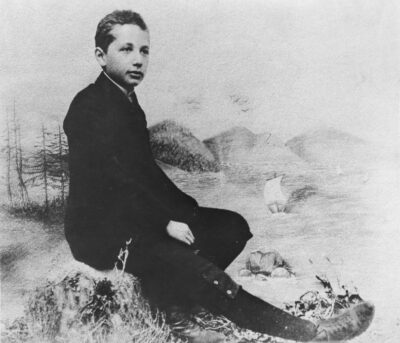
Albert at 14: A Photograph from 1893
1879年から1955年までの生涯
1879年、ドイツのウルムで誕生したアルベルト・アインシュタインは、物理学の歴史に大きな足跡を残しました。
彼の特殊相対性理論は1905年に発表され、時間と空間の概念を根本から変えました。
さらに、1915年には一般相対性理論を完成させ、重力の理解に革命をもたらしました。
アインシュタインは「20世紀最高の物理学者」と称され、ノーベル物理学賞も受賞しています。
彼の研究は揺動散逸定理や粒子と波動の二重性にも及び、量子力学の発展にも貢献しました。
1955年、ニュージャージー州プリンストンでその生涯を閉じましたが、彼の理論は今もなお科学の基礎を支えています。
特殊相対性理論と一般相対性理論の功績
アルベルト・アインシュタインは「20世紀最高の物理学者」として知られ、特殊相対性理論および一般相対性理論を提唱しました。
1905年に発表された特殊相対性理論は、光の速度が一定であることを前提に、時間と空間が相対的であることを示しました。
これにより、ニュートン力学の限界が明らかになり、物理学の新たな地平が開かれました。
一方、1915年に発表された一般相対性理論は、重力を時空の歪みとして説明する理論です。
これにより、天体の運動や光の曲がりなどが精密に予測できるようになりました。
特に、エドウィン・ハッブルによる観測で、一般相対性理論が宇宙膨張の証拠を提供したことは重要な功績です。
また、アインシュタインは揺動散逸定理や粒子と波動の二重性といった概念にも貢献し、量子力学の発展にも大きな影響を与えました。
彼の理論は、現代物理学の基礎を築き、多くの科学技術の進歩に寄与しています。
Life from 1879 to 1955
Albert Einstein, born in 1879 in Ulm, Germany, left an indelible mark on the history of physics. His theory of special relativity, published in 1905, fundamentally changed our understanding of time and space. In 1915, he revolutionized the comprehension of gravity with his general theory of relativity. Celebrated as the greatest physicist of the 20th century, Einstein received the Nobel Prize in Physics. His research extended to the fluctuation-dissipation theorem and the wave-particle duality, significantly contributing to the development of quantum mechanics. Although he passed away in Princeton, New Jersey, in 1955, his theories continue to underpin modern science.
Achievements in Special and General Relativity
Albert Einstein, known as the greatest physicist of the 20th century, introduced the theories of special and general relativity. The special theory of relativity, published in 1905, posited that the speed of light is constant and demonstrated that time and space are relative concepts. This revelation exposed the limitations of Newtonian mechanics and opened new horizons in physics. The general theory of relativity, published in 1915, described gravity as a curvature of spacetime. This theory allowed precise predictions of celestial movements and light bending. Edwin Hubble’s observations provided critical evidence supporting the theory’s prediction of an expanding universe.
Einstein’s contributions also include the fluctuation-dissipation theorem and the concept of wave-particle duality, both of which were pivotal to the advancement of quantum mechanics. His theories laid the foundation for modern physics and have driven numerous technological advancements.
アインシュタインの科学的貢献
アルベルト・アインシュタインは「20世紀最高の物理学者」と称され、その科学的貢献は多岐にわたります。
彼の特殊相対性理論は1905年に発表され、時間と空間の概念を根本から変えました。
この理論により、光速に近づく物体の時間が遅れることが示されました。
1915年には一般相対性理論を発表し、重力を時空の歪みとして説明しました。
また、アインシュタインは揺動散逸定理を提唱し、微細な粒子の動きを統計力学的に説明しました。
さらに、光の粒子と波動の二重性を明らかにし、量子力学の発展に寄与しました。
彼の業績は現代物理学の基礎を築き、多くの科学者に影響を与え続けています。
揺動散逸定理について
揺動散逸定理は、物理学における重要な概念であり、特に「アルベルト・アインシュタイン」の研究に深く関連しています。
この定理は、システムが平衡状態から外れたときに生じる揺動と、その揺動がエネルギーを散逸する過程を説明します。
アインシュタインは、特殊相対性理論および一般相対性理論で知られていますが、揺動散逸定理も彼の研究の一環として評価されています。
粒子と波動の二重性も、この定理と密接に関係しています。
粒子が波として振る舞う現象は、量子力学の基礎を形成し、これにより物質の性質が明らかになりました。
アインシュタインは「20世紀最高の物理学者」として、これらの理論を通じて物理学の発展に大きく貢献しました。
粒子と波動の二重性の理解
「粒子と波動の二重性」は、量子力学の基礎概念の一つであり、アルベルト・アインシュタインの研究が大きな影響を与えました。
彼は、光が粒子としても波動としても振る舞うことを示し、これにより「20世紀最高の物理学者」と称されました。
特殊相対性理論および一般相対性理論は、アインシュタインの業績の中でも特に重要で、物理学の理解を一変させました。
粒子と波動の二重性は、電子や光子などの微小な粒子が、時には粒子として、時には波動として振る舞う現象を指します。
この現象は、ヤングの二重スリット実験で初めて観測され、後に揺動散逸定理などの理論によってさらに解明されました。
これにより、物質の本質的な性質についての理解が深まりました。
アインシュタインは、光電効果の研究を通じて光の粒子性を証明し、ノーベル物理学賞を受賞しました。
彼の理論は、現代物理学の基礎を築き、科学界に大きな影響を与え続けています。
Einstein’s Scientific Contributions
Albert Einstein, celebrated as the greatest physicist of the 20th century, made extensive contributions to science. His special theory of relativity, published in 1905, fundamentally changed our understanding of time and space by showing that time slows down for objects approaching the speed of light. In 1915, he introduced the general theory of relativity, explaining gravity as a curvature of spacetime.
Einstein also proposed the fluctuation-dissipation theorem, providing a statistical mechanics explanation for the motion of tiny particles. Furthermore, he clarified the wave-particle duality of light, significantly advancing quantum mechanics. His work laid the foundation for modern physics and continues to influence scientists worldwide.
Fluctuation-Dissipation Theorem
The fluctuation-dissipation theorem, closely linked to Albert Einstein’s research, is a key concept in physics. It describes the fluctuations occurring when a system deviates from equilibrium and the process through which these fluctuations dissipate energy. While Einstein is renowned for his theories of relativity, the fluctuation-dissipation theorem is another crucial aspect of his work, relating to the wave-particle duality.
The phenomenon of particles behaving as waves forms the basis of quantum mechanics, revealing the intrinsic properties of matter. Einstein’s theories significantly contributed to our understanding of this duality and established him as the greatest physicist of the 20th century.
Understanding Wave-Particle Duality
“Wave-particle duality,” a fundamental concept in quantum mechanics, was profoundly influenced by Albert Einstein’s research. He demonstrated that light exhibits both particle and wave properties, earning him the title of the greatest physicist of the 20th century. His special and general theories of relativity transformed our understanding of physics.
Wave-particle duality refers to the behavior of small particles like electrons and photons, which act as both particles and waves. This phenomenon was first observed in Young’s double-slit experiment and later elucidated by theories such as the fluctuation-dissipation theorem, deepening our comprehension of matter’s essential nature.
Einstein’s work on the photoelectric effect proved the particle nature of light, earning him the Nobel Prize in Physics. His theories underpin modern physics and continue to profoundly impact the scientific community.
アインシュタインの人間像
アルベルト・アインシュタインは「20世紀最高の物理学者」として広く知られています。
彼の特殊相対性理論と一般相対性理論は、物理学の基礎を根本から変革しました。
特にE=mc²という公式は、質量とエネルギーの等価性を示し、科学界に大きな影響を与えました。
アインシュタインはまた、揺動散逸定理や粒子と波動の二重性といった概念にも深く関与しました。
これらの理論は、量子力学の発展に寄与し、現代物理学の理解を一層深めました。
彼の思想は科学だけにとどまらず、平和主義や人権問題にも強い関心を示していました。
アインシュタインは、戦争に反対し、核兵器の使用に対する警告を発しました。
また、教育や学問の自由を重視し、若い科学者たちの育成にも力を注ぎました。
アインシュタインの人間像は、科学者としての卓越した業績だけでなく、社会的な責任感や倫理観に裏打ちされたものでした。
彼の遺した言葉や行動は、今もなお多くの人々に影響を与え続けています。
彼の発言と語録
アルベルト・アインシュタインは、「20世紀最高の物理学者」として広く知られています。
彼の発言と語録は、科学界だけでなく一般社会にも大きな影響を与えました。
特殊相対性理論および一般相対性理論を提唱した彼は、時間と空間の概念を根本から覆しました。
特に「E=mc²」という公式は、質量とエネルギーの等価性を示し、物理学の新たな地平を切り開きました。
また、アインシュタインは揺動散逸定理や粒子と波動の二重性といった複雑な概念をも理解しやすい言葉で説明する能力を持っていました。
彼の「神はサイコロを振らない」という言葉は、量子力学に対する彼の疑念を示す有名な一言です。
このような発言は、科学的な議論を超えて哲学的な問いかけをも引き起こしました。
アインシュタインの語録は、科学者だけでなく多くの人々にとってのインスピレーションの源となり続けています。
彼の言葉は、科学と人間性の融合を象徴しており、今なお多くの人々に影響を与え続けています。
彼の世界観と宗教的感覚
アルベルト・アインシュタインは「20世紀最高の物理学者」として知られ、特殊相対性理論および一般相対性理論を提唱した。
彼の世界観は科学と宗教の融合に深く根ざしている。
アインシュタインは、宇宙の秩序と美を感じ、その根底には何かしらの「高次の調和」があると信じていた。
彼は「揺動散逸定理」や粒子と波動の二重性についても多くの洞察を持ち、科学の枠を超えて哲学的な問いにも向き合った。
アインシュタインは宗教的感覚を「宇宙的宗教感」と呼び、個々の宗教の教義や儀式には関心が薄かったが、宇宙の神秘とその調和に対する畏敬の念を持っていた。
彼の思想は、科学的探求と宗教的感覚が対立するものではなく、むしろ相互に補完し合うものであると示している。
The Human Side of Einstein
Albert Einstein is widely recognized as the greatest physicist of the 20th century. His theories of special and general relativity fundamentally transformed the foundations of physics. Particularly, the equation E=mc², which demonstrates the equivalence of mass and energy, had a profound impact on the scientific community.
Einstein also made significant contributions to the fluctuation-dissipation theorem and the concept of wave-particle duality. These theories advanced quantum mechanics and deepened our understanding of modern physics.
Beyond science, Einstein was deeply concerned with pacifism and human rights. He opposed war and warned against the use of nuclear weapons. He also valued educational and academic freedom, dedicating efforts to mentor young scientists.
Einstein’s persona was characterized not only by his remarkable scientific achievements but also by his strong sense of social responsibility and ethics. His words and actions continue to inspire many today.
His Quotes and Sayings
Albert Einstein, renowned as the greatest physicist of the 20th century, left a legacy of quotes and sayings that impacted not only the scientific community but society at large. His theories of special and general relativity revolutionized our understanding of time and space, particularly with the equation E=mc², which revealed the equivalence of mass and energy.
Einstein had a remarkable ability to explain complex concepts like the fluctuation-dissipation theorem and wave-particle duality in understandable terms. His famous quote, “God does not play dice,” reflects his skepticism about quantum mechanics and sparked philosophical debates beyond scientific discussions.
Einstein’s sayings continue to be a source of inspiration, symbolizing the fusion of science and humanity. His words still resonate with many, influencing both scientists and the broader public.
His Worldview and Sense of Religion
Albert Einstein, known as the greatest physicist of the 20th century, introduced the theories of special and general relativity. His worldview deeply intertwined science and religion, perceiving an underlying “higher harmony” in the universe’s order and beauty.
Einstein held profound insights into the fluctuation-dissipation theorem and wave-particle duality, addressing philosophical questions beyond the scientific realm. He referred to his religious sentiment as a “cosmic religion,” focusing less on individual religious doctrines and rituals and more on a reverence for the universe’s mystery and harmony.
His philosophy suggests that scientific inquiry and religious sentiment are not in opposition but rather complement each other, promoting a holistic understanding of existence.
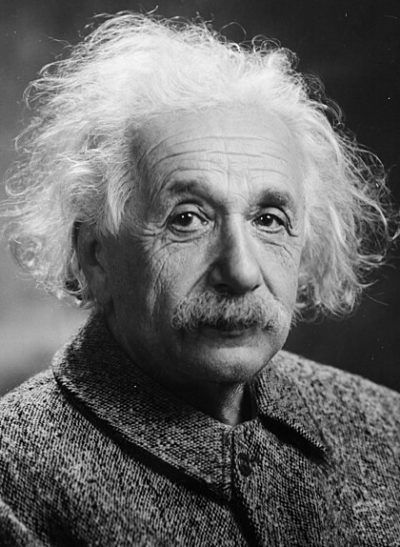
Photograph by Oren J. Turner (1947)
アインシュタインと日本の関係
アルベルト・アインシュタインは、1922年に日本を訪れました。
この訪問は、彼の「特殊相対性理論および一般相対性理論」が世界中で注目を浴びていた時期に行われました。
日本での滞在中、アインシュタインは多くの講演を行い、日本の科学者や学生に大きな影響を与えました。
特に、彼の「揺動散逸定理」や「粒子と波動の二重性」に関する講義は、当時の日本の物理学界に新たな視点を提供しました。
また、アインシュタインは日本文化にも深い興味を持ち、京都や奈良の古寺を訪れ、日本の伝統的な美学に感銘を受けました。
彼の日本滞在は、単なる学術交流にとどまらず、文化的な相互理解の一助ともなりました。
アインシュタインは「20世紀最高の物理学者」と称される一方で、日本との関係を通じて、科学と文化の橋渡し役を果たしました。
アルベルト・アインシュタインは、1922年に「日本」を訪れ、全国各地で講演を行いました。
彼の訪日は「特殊相対性理論および一般相対性理論」の普及に大きく寄与し、特に東京大学での講演は多くの学生や研究者に感銘を与えました。
アインシュタインが講演で触れた「揺動散逸定理」や「粒子と波動の二重性」は、日本の物理学界に新たな視点を提供しました。
彼が「20世紀最高の物理学者」として尊敬される理由の一つは、物理学の基本概念を革新し続けた点にあります。
特に、彼の理論は日本の科学技術の発展に大きな影響を与えました。
アインシュタインの講演は、一般市民にも科学の魅力を伝え、科学教育の重要性を広める契機となりました。
彼の訪日は、単なる学術交流にとどまらず、日本と西洋の文化交流の一環としても評価されています。
Einstein’s Relationship with Japan
Albert Einstein visited Japan in 1922, during a time when his theories of special and general relativity were gaining worldwide attention. During his stay, he gave numerous lectures that greatly influenced Japanese scientists and students. His discussions on the fluctuation-dissipation theorem and the wave-particle duality offered new perspectives to the Japanese physics community.
Einstein also developed a deep appreciation for Japanese culture, visiting ancient temples in Kyoto and Nara, and was impressed by the traditional aesthetics. His visit was not just an academic exchange but also a cultural bridge, fostering mutual understanding.
Known as the greatest physicist of the 20th century, Einstein’s visit to Japan helped to popularize his theories and had a significant impact on the development of Japanese science and technology. His lectures, particularly at the University of Tokyo, left a lasting impression on many students and researchers.
Einstein’s influence extended beyond the scientific community, inspiring the general public and highlighting the importance of science education. His visit is remembered as an important event in the cultural exchange between Japan and the West.

Albert and his wife Elsa warmly welcomed in Japan (around November-December 1922)
日本との接点と講演
アルベルト・アインシュタインは、1922年に「日本」を訪れ、全国各地で講演を行いました。
彼の訪日は「特殊相対性理論および一般相対性理論」の普及に大きく寄与し、特に東京大学での講演は多くの学生や研究者に感銘を与えました。
アインシュタインが講演で触れた「揺動散逸定理」や「粒子と波動の二重性」は、日本の物理学界に新たな視点を提供しました。
彼が「20世紀最高の物理学者」として尊敬される理由の一つは、物理学の基本概念を革新し続けた点にあります。
特に、彼の理論は日本の科学技術の発展に大きな影響を与えました。
アインシュタインの講演は、一般市民にも科学の魅力を伝え、科学教育の重要性を広める契機となりました。
彼の訪日は、単なる学術交流にとどまらず、日本と西洋の文化交流の一環としても評価されています。
Engagement with Japan and Lectures
In 1922, Albert Einstein visited Japan and delivered lectures across the country.
His visit significantly contributed to the popularization of the “Special and General Theory of Relativity,” especially his lectures at the University of Tokyo left a profound impression on many students and researchers.
Einstein’s discussions on concepts like “Fluctuation-Dissipation Theorem” and “Wave-Particle Duality” provided new perspectives to Japan’s physics community.
One of the reasons he is revered as the “greatest physicist of the 20th century” lies in his continuous innovation of fundamental physics concepts.
In particular, his theories had a profound impact on the development of science and technology in Japan.
Einstein’s lectures not only conveyed the allure of science to the general public but also promoted the importance of scientific education.
His visit to Japan is recognized not just as an academic exchange but also as a part of cultural exchange between Japan and the Western world.
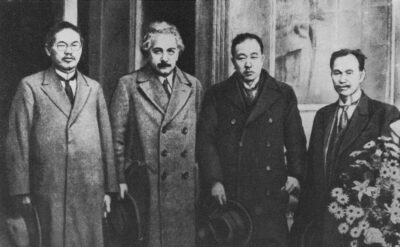
Einstein Visiting Tohoku Imperial University Commemorative Photo (December 1922) [50]. From left: Kotaro Honda, Einstein, Keiichi Aichi, Shirota Kusakabe
第二次世界大戦以降の関係
第二次世界大戦以降、物理学の世界は大きな変革を迎えました。
特に「アルベルト・アインシュタイン」の業績はその中心に位置します。
彼の「特殊相対性理論および一般相対性理論」は、現代物理学の基礎を築きました。
これにより、時間と空間の概念が根本から見直されました。
また、「揺動散逸定理」は、熱力学と統計力学の分野で重要な役割を果たしました。
この定理は、微小な揺らぎがエネルギーの散逸とどのように関連しているかを説明します。
さらに、粒子と波動の二重性の概念も大きな進展を遂げました。
これにより、光や電子が同時に粒子と波動として振る舞うことが理解されました。
20世紀後半には、アインシュタインは「20世紀最高の物理学者」として広く認識されました。
彼の理論は、量子力学や宇宙論の発展に大きな影響を与え、現代科学の礎を築きました。
Commemorative Photo of Einstein’s Visit to Tohoku Imperial University (December 1922) [50]. From left: Kotaro Honda, Einstein, Keiichi Aichi, Shirota Kusakabe
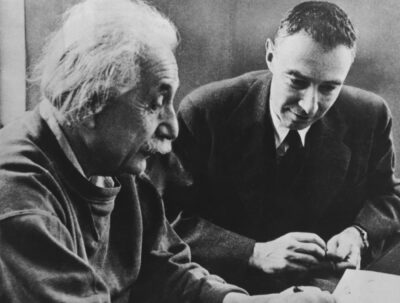
Einstein and Oppenheimer
アルベルト・アインシュタインを描いた作品
アルベルト・アインシュタインを描いた作品には、多数の映画や書籍が存在します。
彼の「特殊相対性理論」や「一般相対性理論」は科学界に革命をもたらし、多くのクリエイターにインスピレーションを与えました。
例えば、2014年の映画『イミテーション・ゲーム』は、アインシュタインの理論が第二次世界大戦中の暗号解読に与えた影響を描いています。
また、アインシュタインの「粒子と波動の二重性」に関する研究は、SF作品のテーマにもなりました。
さらに、アインシュタインの生涯を描いた伝記や小説も多く出版されています。
ウォルター・アイザックソンの『アインシュタイン その生涯と宇宙』は、彼の「20世紀最高の物理学者」としての業績を詳細に記述しています。
アインシュタインの「揺動散逸定理」に関する研究も、科学者たちの間で今なお議論されています。
これらの作品は、アインシュタインの科学的貢献だけでなく、彼の人間性や哲学にも焦点を当てています。
彼の思想や理論は、今後も多くの作品で取り上げられることでしょう。
Here is the English translation:
Artworks Depicting Albert Einstein
There are numerous films and books that portray Albert Einstein, depicting his life and achievements in various ways.
His theories of Special and General Relativity revolutionized the scientific community and inspired many creators.
For example, the 2014 film “The Imitation Game” illustrates how Einstein’s theories influenced code-breaking efforts during World War II.
Additionally, Einstein’s research on the dual nature of particles and waves has become a theme in science fiction works.
Biographies and novels depicting Einstein’s life have also been widely published.
Walter Isaacson’s “Einstein: His Life and Universe” extensively details his accomplishments as “the greatest physicist of the 20th century.”
Research on Einstein’s “fluctuation-dissipation theorem” continues to be debated among scientists.
These works not only highlight Einstein’s scientific contributions but also delve into his personality and philosophical views.
His ideas and theories are likely to continue to inspire numerous works in the future.
アインシュタインの著作と受賞歴
アルベルト・アインシュタインは「20世紀最高の物理学者」として広く知られており、その著作と受賞歴も非常に豊富です。
彼の代表的な著作には、1905年に発表された「特殊相対性理論」と1915年に発表された「一般相対性理論」があります。
これらの理論は、物理学の基礎を大きく変え、現代物理学の礎を築きました。
また、アインシュタインは「揺動散逸定理」や「粒子と波動の二重性」についても重要な貢献をしています。
1921年、アインシュタインは光電効果の理論的解明によりノーベル物理学賞を受賞しました。
この業績は、量子力学の発展に大きな影響を与えました。
さらに、彼の著作「相対性理論の意味」や「物理学における進化」などは、多くの読者に物理学の魅力を伝え続けています。
アインシュタインの業績は、科学界だけでなく、一般社会にも大きな影響を与えました。
彼の理論は技術革新を促進し、現代の科学技術の発展に欠かせないものとなっています。
Einstein’s Works and Awards
Albert Einstein is widely known as the greatest physicist of the 20th century, with a rich repertoire of works and awards.
Among his notable works are the “Special Theory of Relativity,” published in 1905, and the “General Theory of Relativity,” presented in 1915.
These theories fundamentally altered the foundations of physics and laid the cornerstone for modern physics.
Additionally, Einstein made significant contributions to concepts such as the “fluctuation-dissipation theorem” and the “wave-particle duality.”
In 1921, Einstein was awarded the Nobel Prize in Physics for his theoretical explanation of the photoelectric effect, which had a profound impact on the development of quantum mechanics.
Furthermore, his works like “Relativity: The Special and the General Theory” and “The Evolution of Physics” continue to convey the allure of physics to numerous readers.
Einstein’s achievements have not only influenced the scientific community but have also had a profound impact on society at large.
His theories have spurred technological innovations and have become indispensable for the advancement of modern science and technology.
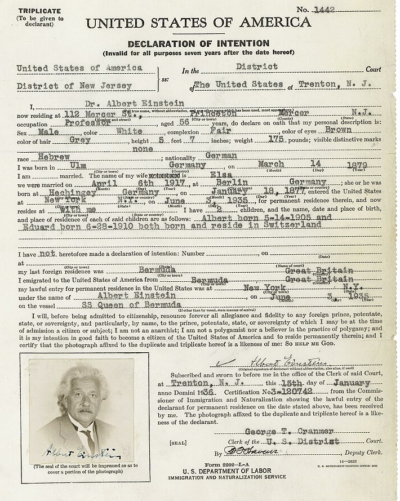
Albert Einstein’s United States Citizenship Application
アインシュタインに関する参考資料
アルベルト・アインシュタインは、20世紀最高の物理学者と称されることが多い。
その理由の一つが「特殊相対性理論」と「一般相対性理論」の提唱である。
1905年に発表された特殊相対性理論は、光速に近い速度での物理現象を説明し、時間と空間の概念を一新した。
これにより、エネルギーと質量の等価性を示す有名な方程式E=mc²が誕生した。
1915年には一般相対性理論を発表し、重力を時空の曲がりとして説明した。
これにより、ニュートンの重力理論を超える新しい視点が提供された。
アインシュタインはまた、揺動散逸定理や粒子と波動の二重性についても重要な貢献をしている。
これらの理論は、現代物理学の基礎を築き、宇宙の理解を深める鍵となった。
彼の業績は、科学だけでなく哲学や文化にも大きな影響を与えた。
アインシュタインの思想や著作は、今なお多くの研究者や愛好者にとって貴重な参考資料となっている。
References on Einstein
Albert Einstein is often regarded as the greatest physicist of the 20th century.
One of the reasons for this is his formulation of the Special Theory of Relativity and the General Theory of Relativity.
Published in 1905, the Special Theory of Relativity explains physical phenomena near the speed of light and revolutionized our concepts of time and space.
This theory gave birth to the famous equation E=mc², demonstrating the equivalence of energy and mass.
In 1915, Einstein introduced the General Theory of Relativity, which describes gravity as the curvature of spacetime.
This provided a new perspective surpassing Newton’s theory of gravity.
Einstein also made significant contributions to concepts like the fluctuation-dissipation theorem and the wave-particle duality.
These theories laid the foundation of modern physics and deepened our understanding of the universe.
His work has had a profound impact not only on science but also on philosophy and culture.
Einstein’s thoughts and writings continue to serve as invaluable reference materials for researchers and enthusiasts alike.
Warning: Undefined variable $comment_form_sns_tags in /home/ktsky/philosophy-kayak.com/public_html/wp-content/themes/shaper/comments.php on line 27

最近はChatGPTや生成AI等で人工知能の普及がアルゴリズム革命の衝撃といってブームとなっていますよね。ニュートンやアインシュタインの理論駆動型を打ち壊して、データ駆動型の世界を切り開いているという。当然ながらこのアルゴリズムにんげんの考えることを模擬するのだがら、当然哲学にも影響を与えるし、中国の文化大革命のようなイデオロギーにも影響を及ぼす。さらにはこの人工知能にはブラックボックス問題という数学的に分解してもなぜそうなったのか分からないという問題が存在している。そんな中、単純な問題であれば分解できるとした「材料物理数学再武装」というものが以前より脚光を浴びてきた。これは非線形関数の造形方法とはどういうことかという問題を大局的にとらえ、たとえば経済学で主張されている国富論の神の見えざる手というものが2つの関数の結合を行う行為で、関数接合論と呼ばれ、それの高次的状態がニューラルネットワークをはじめとするAI研究の最前線につながっているとするものだ。この関数接合論は経営学ではKPI競合モデルとも呼ばれ、様々な分野へその思想が波及してきている。この新たな哲学の胎動は「哲学」だけあってあらゆるものの根本を揺さぶり始めている。この理論どこか多神教的な荘厳さをもっている。
一神教はユダヤ教をその祖とし、キリスト教、イスラム教が汎民族性によってその勢力を拡大させたが、その一神教の純粋性をもっとも保持し続けたのは後にできたイスラム教であった。今の科学技術文明の母体となったキリスト教は多神教的要素を取り入れ例えばルネサンスなどにより古代地中海世界の哲学なども触媒となり宗教から科学が独立するまでになった。一方でキリスト教圏内でも科学と宗教をむしろ融合しようとする働きにより、帝国主義がうまれた。宗教から正当化された植民地戦争は科学技術の壮大な実験場となり、この好循環により科学と宗教を融合させようというのである。その影響により非キリスト教圏で起きたのが日本の明治維新という現象である。この日本全土を均質化した市場原理社会する近代資本主義のスタートとされる明治維新は欧米などの一神教国が始めた帝国主義的な植民地拡張競争に危機感を覚えたサムライたちが自らの階級を破壊するといった、かなり独創的な革命でフランス革命、ピューリタン革命、ロシア革命、アメリカ独立戦争にはないユニークさというものが”革命”ではなく”維新”と呼んできたのは間違いない。しかしその中身は「革命」いや「大革命」とでもよべるべきものではないだろうか。